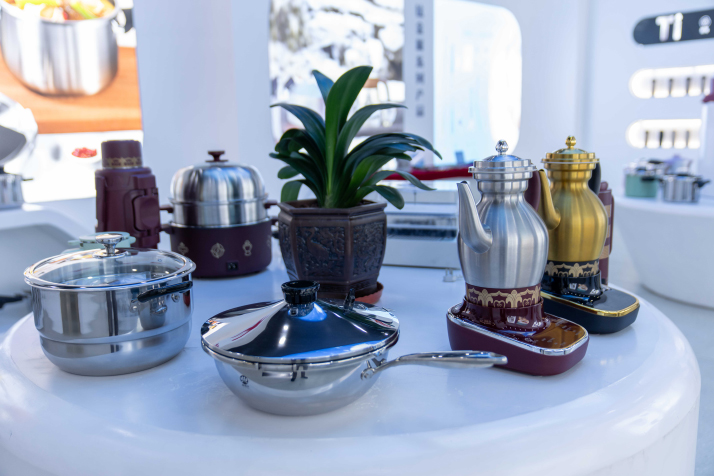| China |
| High-quality cookware makes life easier for families in Xizang | |
|
|
 A staff member assembles a teapot at a cookware company in Xizang Autonomous Region on July 17 (XINHUA)
From an aerial view, Xizang Autonomous Region unfolds like a vast, breathtaking canvas. Snow-capped peaks glisten under the sun, turquoise lakes shimmer like scattered jewels, and endless grasslands stretch across what is known as the Roof of the World. Yet beneath this magnificent beauty lies a challenge that has shaped daily life in the region for generations. At an average altitude of over 4,000 meters, the air here is thin, and thin air means low pressure. This low pressure directly lowers the boiling point of water. In the plateau region, even with a roaring fire, water boils at just over 80 degrees Celsius. For decades, pressure cookers designed for lower altitudes struggled in these conditions. Meals took much longer to cook, testing the patience of users. Frustrated with long cooking times, locals often found themselves improvising by splashing cold water on pressure cookers to bring the pressure down enough to open them. But this quick fix came with risks. Spurting steam, flying food and the occasional burn were all part of the cooking experience. But these inconveniences are already things of the past as, since 2022, multifunctional cookware specifically engineered for the high-altitude environment has gradually entered homes across Xizang, making cooking faster, safer and more efficient.  Products made for plateau areas at a cookware company in Xizang (XINHUA)
Cooking without limits How could people finally break the "curse" of water refusing to boil at 100 degrees Celsius? In 2022, this everyday inconvenience became a top priority for the Xizang regional leadership. A technical group was formed, consisting of the China National Hardware Association, China Daily Hardware Technology Development Center and six leading cookware companies. Their mission was clear: Design and manufacture products that could conquer high-altitude cooking challenges. Because Xizang's terrain spans a wide range of elevations, engineers traveled twice to multiple locations for field research and technical testing. "The data we gathered helped refine the products at every stage," Xu Jian, an engineer on the team, said. Over 20 technical workshops followed, focusing on product design, prototype development and continuous improvements. High-altitude electric kettles [for boiling water] were one of the most technologically difficult innovations as they had no precedents anywhere in the world, Xu told newspaper Economy Daily. "We needed materials that were pressure-resistant, food-safe, durable and affordable. Even selecting the right lid material required countless tests." Despite the challenges, the team succeeded in just three months, creating more than 30 products across seven categories, from pressure cookers to outdoor cookware, introducing features like rapid venting, anti-overflow systems, transparent lids and continuous pressure adjustment. In July 2022, a milestone was reached: The first official standards for multifunctional cookware designed for plateau regions were released. Experts confirmed that the products developed by Xu and his team had reached world-class performance in high-altitude environments and called for their rapid commercialization. That same month, the first production base, Xizang Shangchu Cookware Technology Co. Ltd., was inaugurated in the Lhasa Economic and Technological Development Zone. By the end of the year, its 10 production lines were running at the full capacity of 1 million units annually. To give the products a distinct cultural identity, designers from the Xizang University School of Arts and local enterprises drew inspiration from the most symbolic flower varieties in Xizang and created two trademarks: Snow Lotus and Gesang Flower. In the region, the snow lotus and gesang flower both symbolize happiness and good fortune. Companies meeting the new standards can apply for authorization to use these brands on their products. Snow Lotus and Gesang Flower plateau cookers have become popular among consumers, Wang Junzheng, Secretary of the Communist Party of China Xizang Autonomous Regional Committee, said at a press conference highlighting Xizang's achievements over the past 60 years in Beijing on August 5. According to Wang, the Snow Lotus brand alone has sold more than 1.2 million units, generating 500 million yuan ($69.8 million) in sales revenue. Symbols of happiness The newly developed cookware stands out at first glance: Gleaming stainless-steel bodies and lids displaying temperature settings set them apart from ordinary pressure cookers on the market. Its "one-click pressure release" technology even earned a national patent. Dava Dolma, one of the earliest employees at Shangchu Cookware, has personally purchased dozens of its products for relatives. "The user experience is amazing. As a result, those who first bought the pressure cooker wanted the frying pan, and those who first bought the frying pan wanted the pressure cooker. People are eager to have them," she told Economy Daily. The high-altitude electric kettles offer the same experience as those used in lowland regions. "All control components are concentrated in a small lid, which requires materials with extremely high standards," Xiang Ziyi, head of quality control at the company, told newspaper People's Daily. "After repeated testing, we replaced the heat-resistant plastic pressure-releasing parts with aluminum ones, reducing pressure release time to under 40 seconds and greatly improving the user experience." Though priced at nearly 700 yuan ($98), Xizang residents pay just over 200 yuan ($28), thanks to subsidies from the government's consumer goods trade-in program and company discounts. In 2024, the region introduced guidelines for the old-for-new subsidy for high-altitude multifunctional cookware. Sales of products in this category surpassed 100 million yuan ($14 million) in that year alone. Kunqo Udrup, an early user of the new cookware, now works at Shangchu Cookware as a production line worker. "About 80 percent of my colleagues were born between 1985 and 2000," he told newspaper China Youth Daily. "My wife and I both work here; it's only about 2 km from home. Compared to our previous jobs, we now earn 1,000 to 2,000 yuan ($140-280) more each month." (Printed Edition Title: Performance Under Pressure) Copyedited by G.P. Wilson Comments to liqing@cicgamericas.com |
|
||||||||||||||||||||||||||||||
|